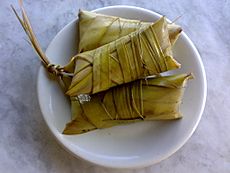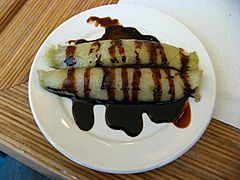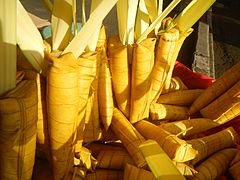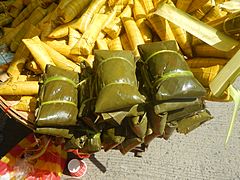Suman (food) facts for kids

Suman sa Ibus, a variety of Suman wrapped in young palm leaves.
|
|
| Alternative names | Rice cake |
|---|---|
| Place of origin | Philippines |
| Main ingredients | Glutinous rice |
Suman (also called budbud) is a yummy rice cake from the Philippines. It's made from a special kind of rice called glutinous rice. This rice is cooked in creamy coconut milk.
Suman is often wrapped in different kinds of leaves, like banana leaves, coconut leaves, or buri palm leaves. These wrappers help steam the suman. People usually eat suman with sugar sprinkled on top or with a sweet coconut sauce called latik. Sometimes, suman is made with cassava instead of glutinous rice.
Contents
Different Kinds of Suman
There are many kinds of suman! Almost every town in the Philippines has its own special recipe. Here are a few examples:
- Binuo (or Suman sa Binuo) – This suman is a bit rare. The glutinous rice is soaked, ground into flour, and then mixed with coconut milk and sugar. It's wrapped in leaves from the Tagbak plant and steamed. These leaves give it a unique, minty taste, and this suman is chewier than others.
- Kurukod (or kurukud) – This type of suman is made from cassava. It has a sweet filling inside made of grated coconut, called bukayo.
- Suman sa Ibus (or just Ibus) – This is a very common suman in the Philippines. The glutinous rice is washed and mixed with salt and coconut milk. This mix is poured into special coil-shaped containers made from young palm leaves called Ibus. Then, it's steamed in water mixed with turmeric, which gives it a yellow color. It's often served with shredded coconut and sugar, or with latik.
- Sumang Inantala – This suman uses similar ingredients to Suman sa Ibus. But for Inantala, the rice mixture is cooked first. Then, it's poured onto small square mats cut from banana leaves.
- Sumang Kamoteng Kahoy – For this suman, cassava is finely ground and mixed with coconut milk and sugar. It's wrapped in banana leaves and then steamed.
- Suman sa Lihiya – Here, soaked glutinous rice and coconut milk are treated with a special ingredient called lye. It's wrapped in banana leaves and boiled for about two hours. It's usually eaten with latik, which can be dark brown (stronger coconut taste) or white (more delicate). This suman is also called Akap-akap because it's often sold in pairs, like they are hugging.
Other Names for Similar Foods
Did you know similar rice cakes are eaten in other countries too?
- In India, Nepal, and Bhutan, it's called marcha.
- In Vietnam, it's benh men.
- In China and Taiwan, it's known as chiu, chu, or daque.
- In Thailand, it's loogpang.
- In Indonesia, it's ragi.
- In Korea, it's nuruk.
The Art of Suman Wrapping
Wrapping suman is a special skill, almost like an art form! People have been doing it for a very long time, even before the Philippines was explored by Europeans. They use many natural materials for wrapping, like palm, banana, anahaw, and bamboo leaves, or even coconut shells.
Some suman wrappers are simple folds, making the suman rectangular. Others are coiled vertically, making the suman look like a tube. Some are shaped like pyramids. There are even suman that look like ice cream cones made from banana leaves! Some wrappers are woven into very fancy shapes, like a heart (called pusu) or even a stingray (called pinagi).
Gallery
-
Two varieties of suman (glutinous rice and cassava)
See also
 In Spanish: Suman para niños
In Spanish: Suman para niños





